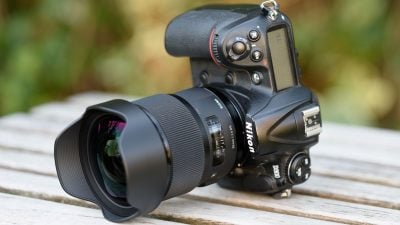Sigma 20mm f1.4 Art review
-
-
Written by Thomas
Quality
Longitudinal Chromatic Aberration and focus shift
With lenses offering an aperture of f2.8 or larger I test for longitudinal CA (loCA, a.k.a. “axial color” or “bokeh CA”). The new Sigma shows some magenta coloration in the foreground (left) and greenish hues in the background (right). This also shows up in real-life shots but is by comparison pretty moderate. By f4.0 the effect is gone. The test also revealed that there is no relevant focus shift.
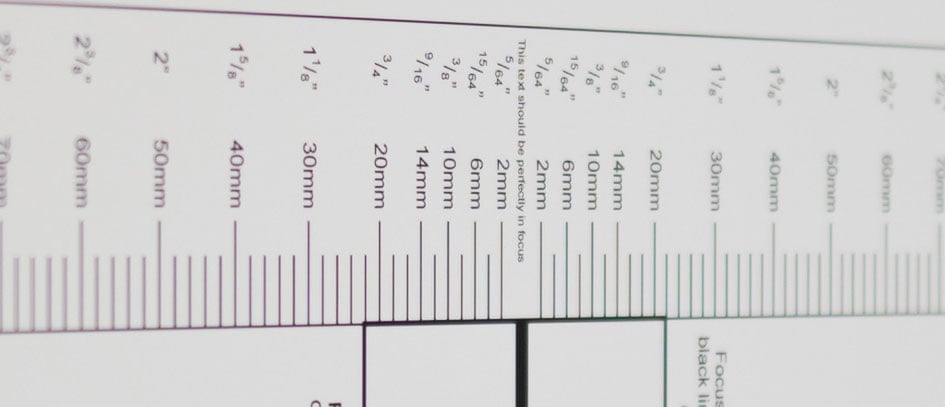
Sharpness and contrast
Let’s have a look at the theoretical performance of the new lens first compared to the performance of the Nikon 20mm f1.8G:
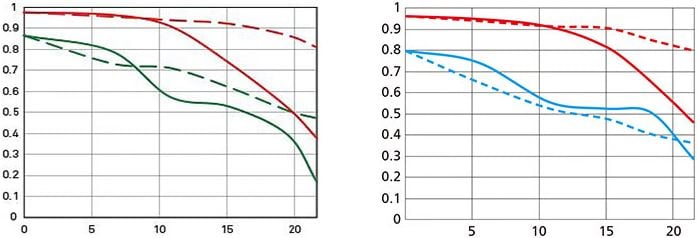
These charts show the lens-performance at the largest aperture. Higher values are better and the closer the dotted and the continuous lines of each color are together the less astigmatism (= resolution depends on the orientation of the test-pattern) the lens has. The x-axis displays the distance from the optical axis (=center of the sensor) in mm. I’ll show you the real-life performance at 4 mm (center), 13 mm (DX-corner), and 20 mm (FX-corner) on a D810.
From the charts, the Sigma should perform slightly better at f1.4 than the Nikon at f1.8. Both lenses show a pronounced drop in sharpness (green resp. blue lines) already at two thirds of the APS-C/DX image-circle (9-10mm) with another drop towards the corners of the FF/FX sensor. As the larger spread between sagittal and meridional performance indicates the Sigma shows a little higher astigmatism in the outer areas than the Nikon – at least on paper. But let’s see how this theoretical performance translates into real life results in the sharpness test based on Siemens-stars.
What follows are near-center results (first column) followed by APS-C/DX-corner results and FF/FX-corner results on a D810. The D810 results from the DX-corner should be a very good approximation for performance on a 16MP DX sensor (like the D7000), because the pixel-pitch of both sensors are the same. But differences in the AA-filter and micro-lens-design of a D810 and a D7000 might yield different end-results.
Processing was done in Lightroom 6.3 from RAW at Camera Standard settings. Noise-reduction is set to 0, sharpening to 35/0.5/36/10, with no extra tone, color, or saturation-adjustment. White-balance was adjusted to a neutral white and I did some exposure compensation to make the brightness match. CA-removal is ON.
The following are all 100% crops!
Sigma 20/1.4 Art on Nikon D810; 100% crop from center, APS-C/DX-corner, FF/FX-corner

Above: 20mm, f1.4

Above: 20mm, f2.0

Above: 20mm, f2.8

Above: 20mm, f4.0

Above: 20mm, f5.6

Above: 20mm, f8.0

Above: 20mm, f11
These 100% crops directly from a 36MP D810 sensor shows a very good performance of this lens. At f1.4 it’s very sharp in the center with some softness in the DX-corner and a hazy FX-corner that shows some coma. Compared to its longer sibling, the 24/1.4 Art, the new lens produces a sharper DX-corner and has also less coma in the FX-corner. Focus was optimized for the outer crops here but there is really only very little field-curvature. Stopping down to f2.8 produces very good sharpness and contrast across the full-frame sensor. Diffraction is clearly setting in at f11. Distortions seem pretty low for such a wide-angle lens.
Following is a direct comparison of the Sigma (1st row) to the Nikon AF-S 20mm f1.8 (2nd row) at f2.0:

Above: Sigma 20/1.4 Art at 20mm, f2.0

Above: Nikon 20/1.8G at 20mm, f2.0
At f2.0 the new Sigma is better in every crop than the Nikon 20/1.8. But the Nikon is not too far behind.
Following is a direct comparison of the Sigma (1st row) to the Tamron 15-30mm f2.8 VC (2nd row) at 18mm f2.8:

Above: Sigma 20/1.4 Art at 20mm, f2.8

Above: Tamron 15-30mm f2.8 VC at 18mm, f2.8
Well now, this is quite a surprise: The Tamron zoom matches the image quality of the new Sigma at f2.8 and even slightly surpasses it in the DX-corner. It also produces very little field curvature at 18mm. This is testament to the excellent image quality that the Tamron SP 15-30/2.8 VC delivers.
Performance at long distances
The Siemens-star test-targets are shot at a distance of 40x focal length. But performance of lenses also depends on the shooting distance. Therefore I do another series of test-shots of a landscape dubbed the “Unremarkables” where you can measure distances in km, not meter. I use this scene to show you how the lenses perform when almost everything is at infinity. There’s no tinkering with vignette-control so you see it here as it is produced by the lens. Focus was manually acquired at the largest aperture in live-view and not changed for other apertures.
You can click on the image to access the large original. Please respect our copyright and only use those images for personal use.
The main image shows the complete scene at maximum aperture to give you an impression of the angle of view and to judge vignetting. This is followed by one row of 100% crops from f1.4 to f8 each from the middle, the APS-C/DX-corner and the right FF/FX-corner.
You can access the respective shots up to f16 via the links beneath the main image.
Sigma 20/1.4 Art shot with Nikon D810
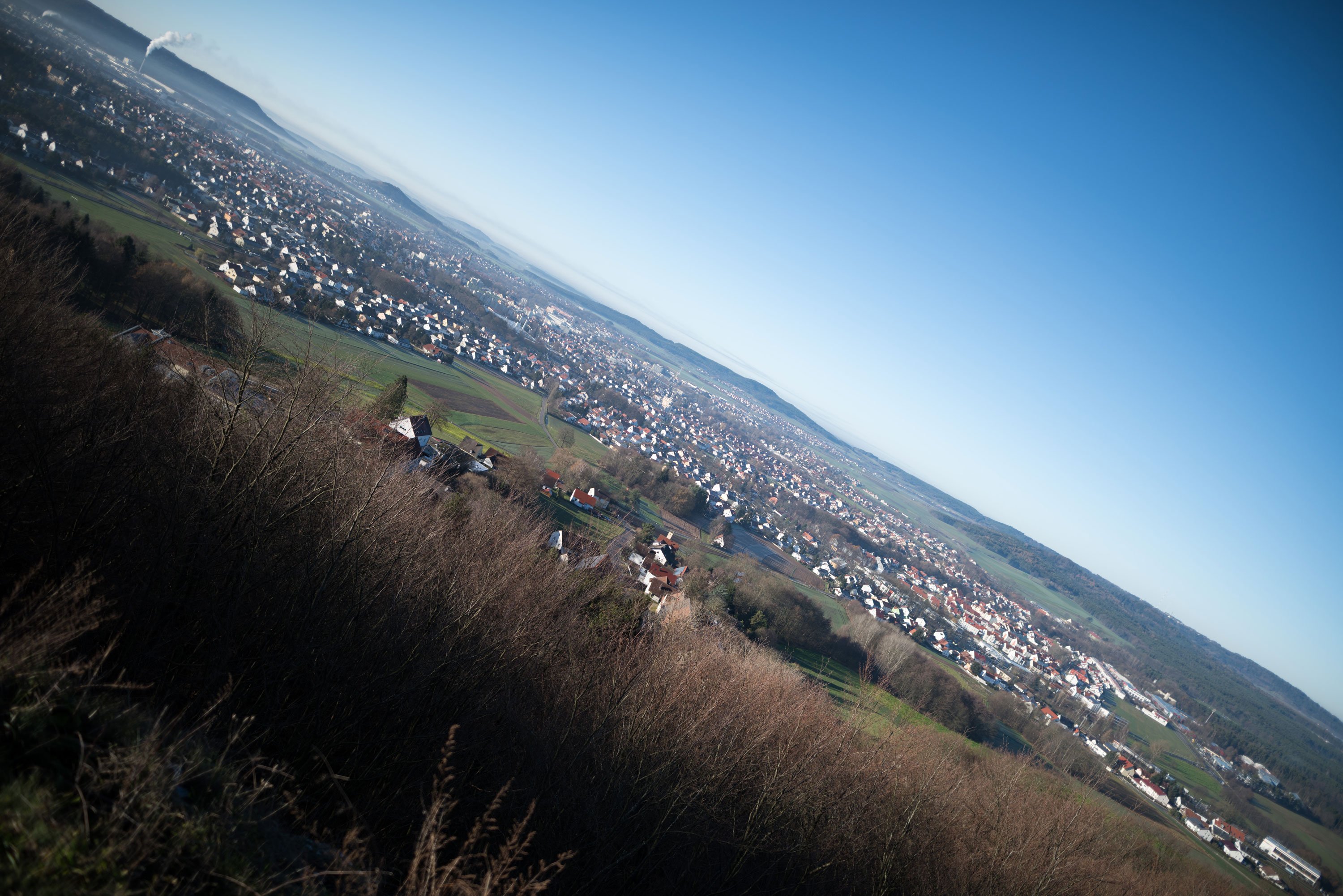
20mm, f1.4, 64 ISO; also available at f1.8, f2.0, f2.8, f4.0, f5.6, f8.0, f11, f16

Above: 20mm, f1.4; 100% crop from center, APS-C/DX-corner, FF/FX-corner

Above: 20mm, f2.0; 100% crop from center, APS-C/DX-corner, FF/FX-corner

Above: 20mm, f2.8; 100% crop from center, APS-C/DX-corner, FF/FX-corner

Above: 20mm, f4.0; 100% crop from center, APS-C/DX-corner, FF/FX-corner

Above: 20mm, f5.6; 100% crop from center, APS-C/DX-corner, FF/FX-corner

Above: 20mm, f8.0; 100% crop from center, APS-C/DX-corner, FF/FX-corner
Performance is very good even wide open in the center and astonishingly good in the FX-corner. I just wish that the sharpness at the APS-C/DX-corner would be a bit better. Stop down to f4.0 to get excellent clarity across the sensor and very low vignetting. Below is a comparison with the Nikon 20/1.8G at f2.0 and the Tamron 15-30/2.8 VC at18mm f2.8. I couldn’t shoot the scenes on the same day, so atmospheric conditions are different between the shots. I tried to match WB and exposure though to make the shots as comparable as possible:

Above: Sigma 20/1.4 Art on Nikon D810 at f2.0; 100% crop from center, APS-C/DX-corner, FF/FX-corner

Above:Nikon 20/1.8G on Nikon D800 at f2.0; 100% crop from center, APS-C/DX-corner, FF/FX-corner
At f2.0 the Nikon comes close in the center and the FX-corner, but the Sigma is clearly better at the APS-C/DX-corner.

Above: Sigma 20/1.4 Art at f2.8; 100% crop from center, APS-C/DX-corner, FF/FX-corner

Above: Tamron 15-30/2.8 VC at 18mm, f2.8; 100% crop from center, APS-C/DX-corner, FF/FX-corner
Again the Tamron surprises with an even sharper reproduction at 18mm f2.8 in the DX- and FX-corner than the Sigma.
Vignetting
To make it easier to judge light fall-off in the corners of a full-frame sensor I’ve arranged a series of three shots from a neutral white background at different apertures. For such a wide large aperture full-frame lens I find the fall-off to be pretty low. It can be completely corrected with a lens profile in Lightroom:

Above: Sigma 20/1.4 Art at f1.4, f2.0, f2.8
Rendering of point-light sources at night-shots
Night-shots pose a different challenge for lenses as the contrast is even higher than under bright sun and point-light sources can reveal some weaknesses such as coma, haloing and color-aberrations that do not show up as prominently in other test-shots. The 100% crops below the main image show the effect of coma in the FX corner of the Sigma at various apertures. From f4.0 the effect is negligible:
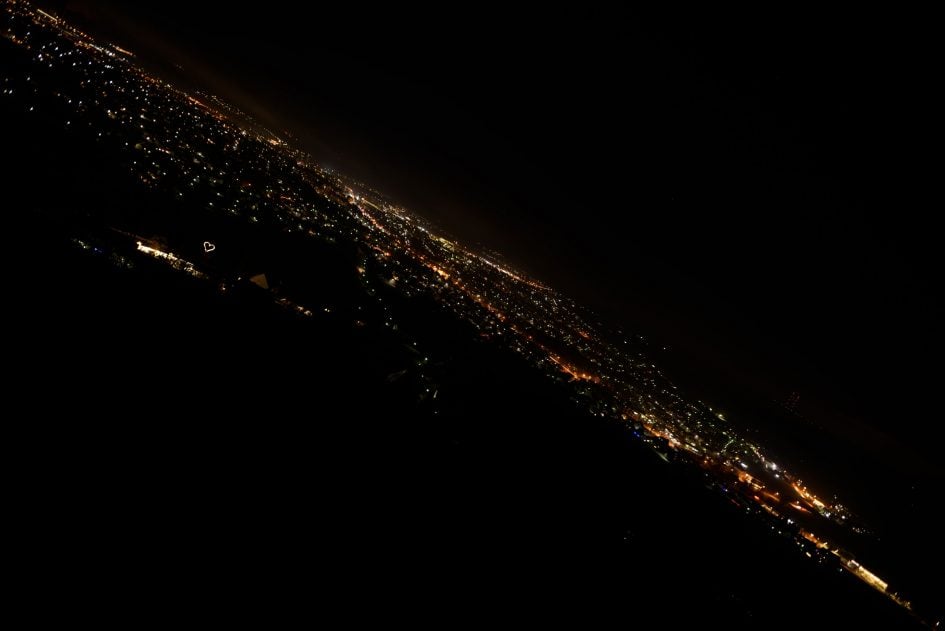
Above: Sigma 20/1.4 Art at f1.4; also available at f2.0, f2.8, f4.0, f5.6

Above: Sigma 20/1.4 Art; FX-corner at f1.4 (left), f2.8 (middle), f4.0 (right)
Coma is clearly visible at f1.4 but not as bad as you can see at other f1.4 lenses. Stopping down reduces the effect pretty fast. The following crops show the performance from the Nikon and the Tamron:

Above: Nikon 20/1.8G; FX-corner at f1.8 (left), f2.8 (middle), f4.0 (right)

Above: Tamron 15-30/2.8 VC at 18mm; FX-corner at f2.8 (middle), f4.0 (right)
At f2.8 the Tamron produces very little coma, the Nikon is the worst and the Sigma is somewhere in-between. At f4.0 the effect is almost negligible.
Rendering of out-of-focus point-light sources
This test is for the rendering of point-light sources in an out-of-focus background. The circle of confusion that is produced by this test is pretty indicative of Bokeh performance (in the background) and light fall-off. Ideally the out-of-focus image of the point-light is evenly lit and perfectly circular, with no “onion-rings”, and without coloration. Large aperture lenses normally produce an effect known as “cat’s eye” the further away from the optical axis the point-light is projected. This is due to optical vignetting in the lens barrel when light enters the lens from an angle.
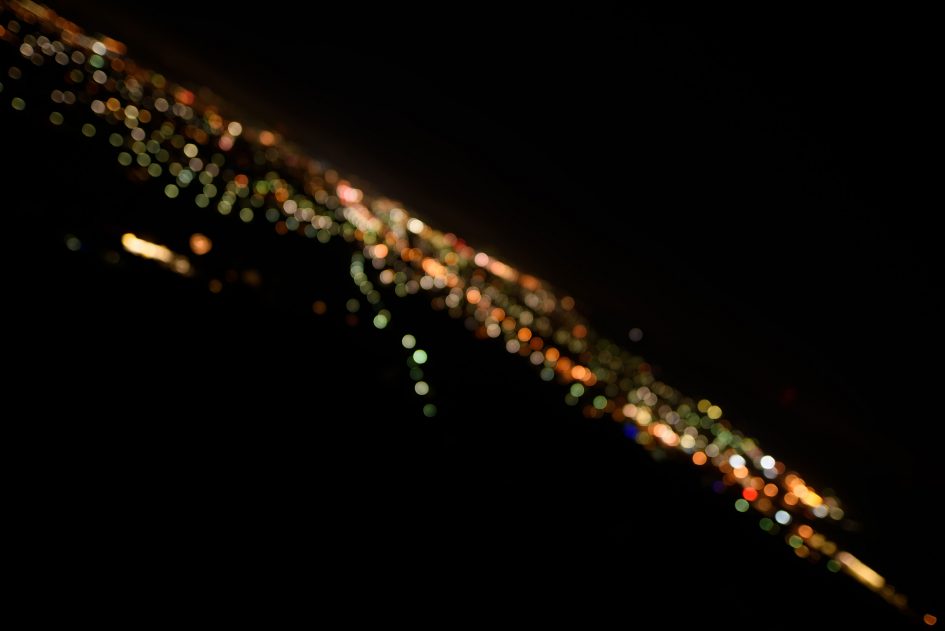
Click image to access original at Flickr; also available at f2.0, f2.8, f4.0, f5.6

Above: Sigma 20/1.4 Art at f1.4. 50% crop from center, APS-C/DX-corner, FF/FX-corner.
As the 50% crops above show: The Sigma 20/1.4 Art produces not the fattest circle of confusion. But that was not to be expected with a 20mm lens. It exhibits only slight onion rings and the light-distribution across the circle is relatively even. Outlining is also moderate unless you look into the FF/FX-corner where the “Bokeh balls” are also squeezed albeit still pretty big. There is no clipping from the mirror-box. Let’s see how the Nikon and Tamron compare:

Above: Nikon 20/1.8G at f1.8. 50% crop from center, APS-C/DX-corner, FF/FX-corner.

Above: Tamron 15-30/2.8 VC at 30mm, f2.8. 50% crop from center, APS-C/DX-corner, FF/FX-corner.
Both the Nikon and the Tamron produce clearly less desirable Bokeh balls with the Tamron being the worst: It produces the smallest circles of confusion although used at 30mm focal length here and also shows pronounced onion-rings and quite some outlining. The Nikon is somewhere in-between.
Now let’s see how this analysis of out-of-focus point-light sources translates into Bokeh-performance shooting a book-shelf.
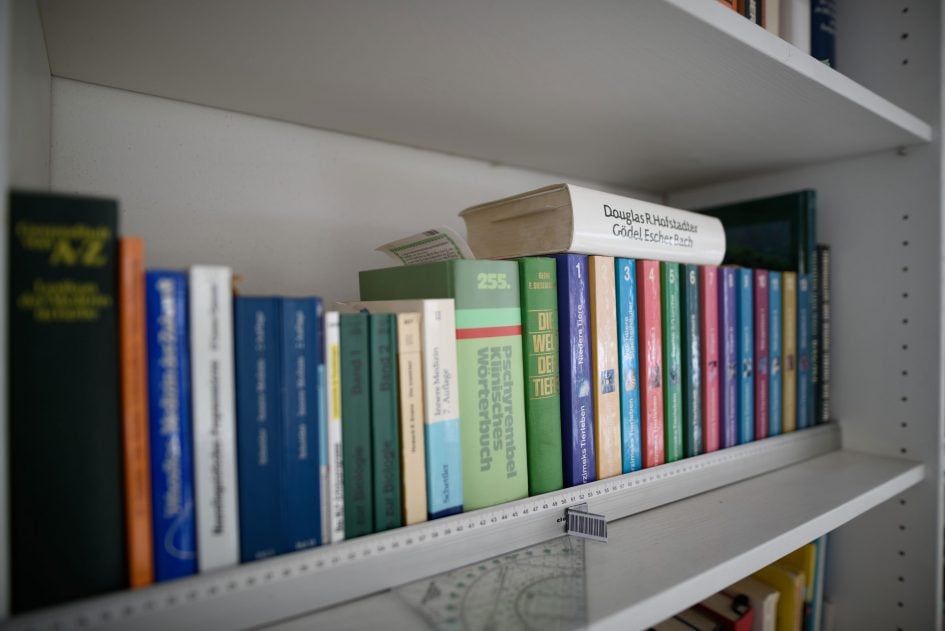
Above: Sigma 20/1.4 Art at f1.4. Click image to access original at Flickr; also available at f2.0, f2.8, f4.0, f5.6

Above: Sigma 20/1.4 Art at f1.4. 50% crop from foreground, middle-ground, background
The (less important) foreground is nicely blurred and the middle ground stays clean of color artifact often seen with other large aperture lenses. But the background shows some outlining which makes the Bokeh a bit nervous albeit less than from the Sigma 24/1.4 Art. Let’s see how the Nikon and Tamron compare:

Above: Nikon 20/1.8G at f1.8. 50% crop from foreground, middle-ground, background

Above: Tamron 15-30/2.8 VC at 30mm, f2.8. 50% crop from foreground, middle-ground, background
The foreground is best with the Sigma at f1.4 followed by the Nikon (at f1.8) and the Tamron (which was shot at 30mm f2.8 in this comparison). The middle-ground is clearly best from the Sigma with the Nikon producing less of a blur and showing some greenish coloration from longitudinal CA. The Tamron is the worst regarding Bokeh as it almost does not show any blur in the middle-ground at all and also has the weakest blur in the background of the three lenses.
Flare/ghosting
Catching a strong light-source shining directly into the lens is a major risk with wide-angle lenses – even with the lens-hood attached. That could produce strange colorful ghosts-images or reduce contrast considerably through flare and glare. The appearance of flare and ghosting depends on factors like the aperture and the angle of the light hitting the lens. So to judge the proclivity of the Sigma for these artifacts I went through a series of well calculated shots against a strong light source to provoke glare and ghosting.
The results are very good: Wide open the lens produced only very little flare and the blacks were really black. At f8.0 the test provoked some flare and ghosting artifacts:
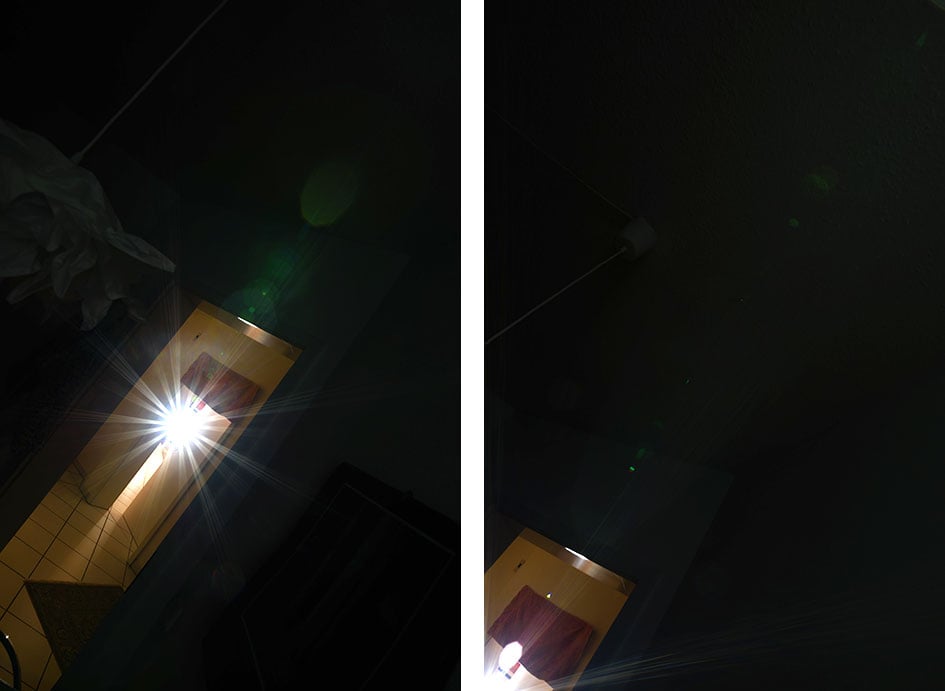
Above: Flare and ghosting. Strong light hitting the Sigma 20/1.4 Art at f8.0




